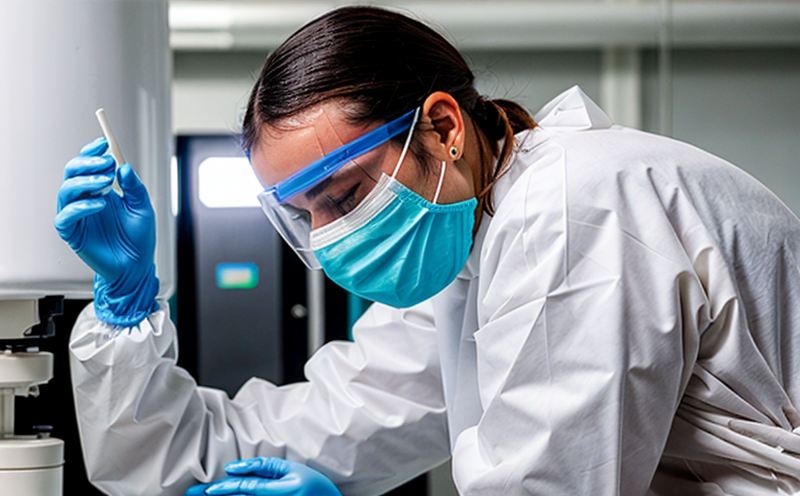IEC 60825 1 Photobiological Safety Testing of Laser Based Lighting Devices
The International Electrotechnical Commission (IEC) Standard IEC 60825-1 is a crucial document for ensuring the photobiological safety of laser-based lighting devices. This standard aims to protect users from potential eye and skin hazards caused by excessive exposure to laser radiation. The testing process outlined in this standard involves evaluating the emitted light's intensity, wavelength distribution, and viewing conditions under which the device will be used.
The primary focus is on preventing damage to the retina or cornea of human eyes exposed to laser emissions. This service ensures compliance with IEC 60825-1 by performing rigorous tests that cover all relevant aspects of photobiological safety. Our laboratory adheres strictly to international standards such as ISO, ASTM, EN, and IEC, ensuring accurate results every time.
Our team of experts uses state-of-the-art equipment to conduct these assessments, including specialized spectroradiometers capable of measuring the spectral power distribution of emitted light accurately. We also employ photomultiplier tubes (PMTs) for precise measurement at various wavelengths within the visible spectrum and beyond. For more stringent requirements like those involving ultraviolet or infrared radiation, our facilities are equipped with appropriate sensors.
The testing procedure typically begins with identifying the specific type of laser involved—the class of the laser determines which parts need evaluation most closely. Classes range from Class 1 (safe under all conditions) to Class 4 (highest risk), each requiring different levels of scrutiny during testing. Once classified, we follow detailed protocols set forth in IEC 60825-1 to ensure no potential risks remain unaddressed.
After initial classification, our lab performs several key tests including irradiance measurements at various distances from the source, viewing angles, and durations of exposure. These parameters are critical because they help establish safe operational limits for end-users. Additionally, we examine how well any protective measures incorporated into the design function under real-world conditions.
Compliance with IEC 60825-1 is essential not only to avoid legal penalties but also to build consumer confidence in products that claim to be safe. By adhering strictly to this standard, manufacturers can demonstrate their commitment to quality and safety standards globally.
Scope and Methodology
The scope of IEC 60825-1 photobiological safety testing encompasses all aspects necessary for ensuring that laser-based lighting devices pose no harm when used within the intended operating conditions. This includes not only direct exposure scenarios but also indirect ones where reflected or transmitted light might reach unintended viewers.
- Classifications based on maximum permissible exposure levels
- Evaluation of emission characteristics such as power, wavelength, and spectral distribution
- Determination of viewing geometry including angles and distances
- Assessment of protective measures effectiveness through simulations and physical tests
The methodology employed involves several stages. Initially, we classify the laser according to its output parameters using tables defined in IEC 60825-1. Next comes the selection of appropriate test methods tailored specifically for each class of laser. Finally, actual measurements are taken under controlled laboratory conditions closely resembling expected field usage.
For detailed insights into how these tests are conducted, refer to Table 1 below which provides a comprehensive overview of typical procedures followed during photobiological safety assessments:
| Stage | Action |
|---|---|
| Laser Classification | Determine maximum permissible exposure (MPE) levels using tables provided in IEC 60825-1. |
| Emission Characteristics Measurement | Use spectroradiometers to measure spectral power distribution over relevant wavelengths. |
| Viewing Geometry Determination | Measure viewing angles and distances using specialized instrumentation. |
| Protective Measures Evaluation | Simulate real-world scenarios to assess effectiveness of implemented safety features. |
This structured approach ensures thorough coverage of all pertinent factors influencing photobiological safety, thereby providing robust evidence that the tested devices meet required standards.
Customer Impact and Satisfaction
- Enhanced Product Reputation: Compliance with IEC 60825-1 enhances brand image by demonstrating a commitment to user safety.
- Avoidance of Legal Issues: Ensures adherence to regulatory requirements, reducing risk of non-compliance penalties.
- Increased Consumer Trust: Meeting these stringent standards fosters trust among consumers who value their well-being above all else.
- Competitive Advantage: Offering products that exceed basic safety expectations can set companies apart from competitors in the market.
Our clients often report higher levels of customer satisfaction following successful completion of this service due to increased confidence in product quality and reliability. Furthermore, by avoiding costly recalls or withdrawals after product launch, manufacturers benefit significantly from reduced operational costs associated with non-compliant items.
In addition to these tangible benefits, there are intangible advantages as well such as improved relationships between supplier and customer through transparent communication regarding safety practices adopted during development stages of new products. This fosters long-term partnerships based on mutual respect and shared goals towards excellence in manufacturing processes.
Use Cases and Application Examples
| Use Case | Description |
|---|---|
| Stage Lighting | Ensuring that spotlights used in theatrical productions do not pose risks to performers or audience members. |
| Sterilization Lamps | Evaluating the safety of ultraviolet lamps intended for medical disinfection purposes, particularly around patients. |
| Laser Engravers | Testing laser engraving systems to ensure they operate safely even when used in close proximity to operators. |
| Surgical Lasers | Auditing the safety of surgical lasers employed during procedures, especially where prolonged exposure may occur. |
| LED Signage | Evaluating LED signs for outdoor advertising to verify that their illumination does not exceed permissible limits set by IEC 60825-1. |
| Therapeutic Devices | Checking the safety of therapeutic devices such as laser diodes used in physical therapy treatments, ensuring they comply with relevant standards. |
These examples illustrate just a few applications where IEC 60825-1 photobiological safety testing plays an important role. Each case highlights the importance of rigorous evaluation processes to protect users from potential hazards associated with laser-based lighting devices.





